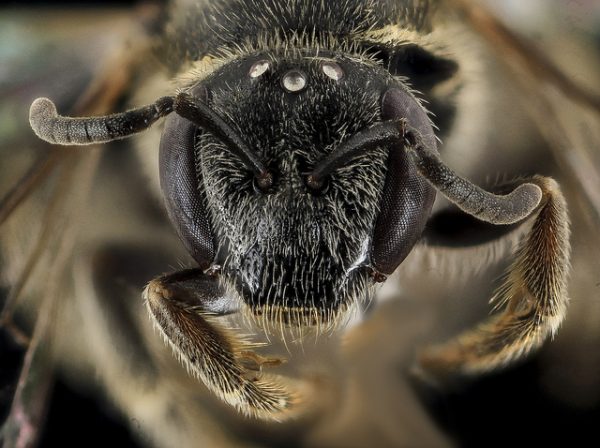Don’t sweat our native bees

There was that glorious day toward the end of August when the humidity dropped and the heavens parted. The air felt fresh for the first time in months. I knew it wouldn’t last – we were bound to have another spell of muggy weather before the start of autumn – but I convinced myself the pattern would hold through Labor Day. As I looked forward to a splendid weekend in the Uwharries, I fantasized about pulling on a sweatshirt against the evening chill.
Instead, “sweat shirt” was an uncomfortably accurate description of the light-weight tops I wore all weekend. The moderate temperatures were deceptive. The humidity was oppressive, as bad as it had been all summer. The air was still, even on our breezy ridge, as if the wind had decided it was also entitled to take a few days off. All manner of insect descended on us. We suffered a plague of mosquitoes and large, hard-bodied gnats, but in terms of sheer numbers and persistence, sweat bees were the worst offenders. They were a nuisance throughout the day and even after sunset.
|
Photos of bees Click here for more information about the photo above. See more photos from Sam Droege at the USGS bee inventory and monitoring lab photostream. |
Anyone observing us from a distance – scowling, cursing and flailing our arms – would’ve surely thought we’d lost our minds. I began to think of sweat bees as the insect version of Chinese water torture. Given their attraction to the salts in our perspiration, they tend to show up in droves when I’m already a little cranky and irrational. I’ve since learned the trick to dealing with sweat bees is to attain the detachment of a Zen master. Let them land and take a harmless sip. Transcend the urge to swat them away. If pressed against your skin, the females extract revenge in the form of a gentle sting.
They spent so much time tormenting us, I questioned whether they served any real purpose in our ecosystem. As it turns out, sweat bees mate during visits to flowers, making them invaluable as pollinators. Honey bees usually get the lion’s share of the credit for pollination, and their importance has been highlighted in recent years due to their decline from “colony collapse.” While these European imports are indeed vital to many crops, native bees such as sweat bees, bumble bees and miner bees are the ones who get the job done when it comes to our wildflowers. They’re also better at pollinating fruits and vegetables that originated in the Americas such as tomatoes, pumpkins, blueberries, cranberries and cherries. Honey bees are the high-performance but temperamental Porsche, while our native bees are the dependable Ford that chugs along without a lot of fanfare.
Desperate farmers out West have been devising ways to attract the blue orchard bee to their almond and cherry orchards as a replacement for the beleaguered honey bee. They drill holes in boards and set them up among the trees, enticing workers with an easy commute and affordable housing for their families. Alfalfa farmers are also going to great lengths to attract a species of my nemesis, the sweat bee. They mimic the habitat sought by the alkali bee, which nests in the ground in dense aggregations, by laying out tarps near their fields and covering them with alkali clay.
Some people have begun to do the same thing on a smaller scale in their backyards and gardens. Attracting native bees can be as simple as leaving a patch of bare ground. More industrious folks make nests by drilling holes in a piece of wood or bundling together a bunch of hollow twigs or paper drinking straws. Perhaps the most important intervention is to eliminate or reduce the use of pesticides. Apply them sparingly and strategically, if at all, avoiding the middle of the day when pollinators are most active.
As a kid who ran barefoot much of the summer, I stepped on my fair share of honey bees. Unpleasant as it was to have the barbed stinger tweezed from my foot, at least I wasn’t given to anaphylactic reactions. For those allergic to bee stings, it might be a comfort to know that native bees are generally much more docile than honey bees, and many don’t sting at all, so you can invite them into your garden without dramatically increasing the risk of turning to your EpiPen. In addition to being helpful pollinators, many of them are quite beautiful, especially – you guessed it – the sweat bees. Seen up close, they’re resplendent in metallic shades of copper, gold, blue, green and black. The ones that bedeviled me in the Uwharries over Labor Day weekend have a rusty head, a dark thorax and a gold and black banded abdomen.
After researching this article, largely through an excellent booklet from the Pollinator Partnership (www.pollinator.org), I’ve decided to be more tolerant of sweat bees. When sticky summer weather rolls around again, I’ll take a deep breath and close my eyes and focus on an image of a brilliant green sweat bee dusted with pollen from a yellow composite, then I’ll try to meditate away the urge to squash it.